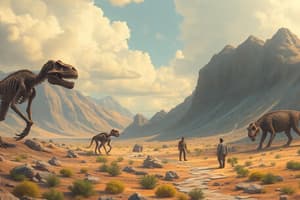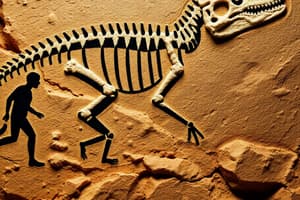Podcast
Questions and Answers
Which of the following is a term used for similar characteristics shared by organisms?
Which of the following is a term used for similar characteristics shared by organisms?
- Plate Tectonics
- Homology (correct)
- Artificial Selection/Agriculture
- Fossil Records
What do the pair of arms of humans and the wings of bats demonstrate?
What do the pair of arms of humans and the wings of bats demonstrate?
- Homologous Structures (correct)
- DNA Sequences
- Plate Tectonics
- Fossil Records
What does the presence of homologous structures suggest about DNA and protein sequences?
What does the presence of homologous structures suggest about DNA and protein sequences?
- They are unrelated
- They are unique
- They are also homologous (correct)
- They are identical
According to the Continental drift theory, what caused the shifting of different continents?
According to the Continental drift theory, what caused the shifting of different continents?
What does the figure of similar fossil records of different continents suggest?
What does the figure of similar fossil records of different continents suggest?
What does the similarity in DNA sequences among different species suggest?
What does the similarity in DNA sequences among different species suggest?
What is the process called when certain organisms diversify or develop specialization due to changes in environment and geographic locations?
What is the process called when certain organisms diversify or develop specialization due to changes in environment and geographic locations?
What term is used for the intentional selection of breeding pairs to produce offspring with favorable traits?
What term is used for the intentional selection of breeding pairs to produce offspring with favorable traits?
Which theory suggests that all species of life on Earth are related and have descended from a common ancestor?
Which theory suggests that all species of life on Earth are related and have descended from a common ancestor?
What is the process called when two species depend on each other for survival and their evolution is connected?
What is the process called when two species depend on each other for survival and their evolution is connected?
Which mechanism of evolution involves the survival of the more evolved and dominant species?
Which mechanism of evolution involves the survival of the more evolved and dominant species?
What helps us understand how life on Earth evolved over time?
What helps us understand how life on Earth evolved over time?
What does artificial selection involve?
What does artificial selection involve?
Which theory suggests that individuals with traits better suited to their environment are more likely to survive and reproduce?
Which theory suggests that individuals with traits better suited to their environment are more likely to survive and reproduce?
What is the evidence of birds as direct descendants of certain dinosaurs?
What is the evidence of birds as direct descendants of certain dinosaurs?
What is defined as the variability of organisms that came into existence?
What is defined as the variability of organisms that came into existence?
Study Notes
- Protein synthesis lesson objective: describe evidence of evolution, including homology, DNA and protein sequences, plate tectonics, fossil records, and artificial selection/agriculture.
- Homology: similar structures shared by organisms, such as the pair of arms in humans and wings in bats.
- Homology suggests presence of similar DNA and protein sequences, indicating common ancestry.
- Plate tectonics and fossil records: continental drift theory explains how continents moved and isolated landmasses, leading to differentiation and adaptive radiation.
- Fossil records provide evidence of evolution by showing similarities between fossils from different continents.
- Artificial selection/agriculture: intentional breeding of organisms to produce offspring with favorable traits contributes to the proof of evolution.
- Evolution is a dynamic process of adaptation driven by various factors, resulting in biodiversity.
- Descent with modification and natural selection theories describe the process of evolution, where organisms continuously descend from ancestors with new modifications and the survival of the more evolved and dominant species.
- Coevolution, convergent evolution, and divergent evolution are mechanisms by which organisms evolve.
- Coevolution refers to the evolutionary connection between two species that depend on each other for survival.
- Convergent evolution is the process by which organisms develop similar features despite different evolutionary histories.
- Divergent evolution is the process by which organisms diverge from a common ancestor to develop distinct traits.
Studying That Suits You
Use AI to generate personalized quizzes and flashcards to suit your learning preferences.
Description
Test your knowledge on the evidence of evolution such as homology, DNA and protein sequences, plate tectonics, fossil records, embryology, and artificial selection/agriculture. Explore the different evidence that support evolution.




